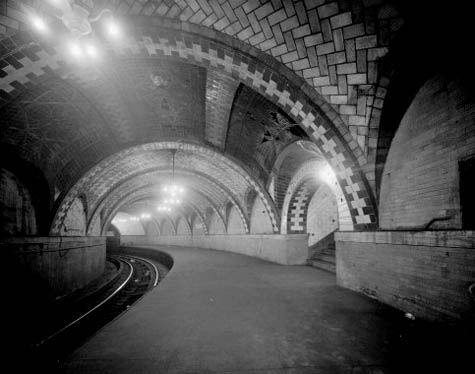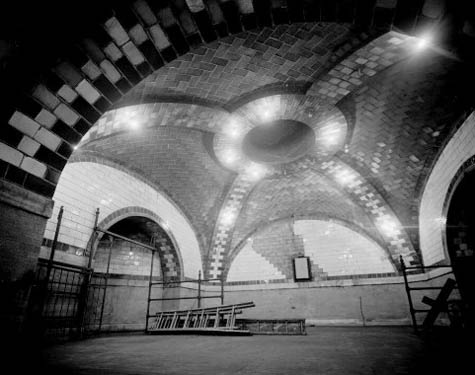BLDGBLOG (3)
By:
July 31, 2010
The Rentable Basement Maze
 [Image: The subterranean vaults of Manhattan, seen here in City Hall station, which closed in December 1945; photo by David Sagarin (1978), via the Library of Congress, Prints and Photographs Division, Historic American Engineering Record of the Heritage Conservation and Recreation Service].
[Image: The subterranean vaults of Manhattan, seen here in City Hall station, which closed in December 1945; photo by David Sagarin (1978), via the Library of Congress, Prints and Photographs Division, Historic American Engineering Record of the Heritage Conservation and Recreation Service].
A city with an abandoned underground train line, one that cuts beneath some of the nicest townhouses in the city, develops an unexpected new real estate idea: renting out temporary basements in the form of repurposed subway cars.
Access stairs are cut down from each individual house till they connect up with the existing disused train tunnels below; each private residence thus becomes something like a subway station, with direct access, behind a locked door, to the subterranean infrastructure of the city far below.
Then, for a substantial fee — as much as $15,000 a month — you can rent a radically redesigned subway car, complete with closets, shelves, and in-floor storage cubes. The whole thing is parked beneath your house and braked in place; it has electricity and climate control, perhaps even WiFi. You can store summer clothes, golf equipment, tool boxes, children’s toys, and winter ski gear.
When you no longer need it (or can’t pay your bills), you simply take everything out and the subway car is returned to the local depot.
A veritable labyrinth of moving rooms soon takes shape beneath the city.
 [Image: The great and abandoned Manhattan underdome, photo by David Sagarin (1978), via the Library of Congress, Prints and Photographs Division, Historic American Engineering Record of the Heritage Conservation and Recreation Service (which includes many other incredible photographs of that subway line)].
[Image: The great and abandoned Manhattan underdome, photo by David Sagarin (1978), via the Library of Congress, Prints and Photographs Division, Historic American Engineering Record of the Heritage Conservation and Recreation Service (which includes many other incredible photographs of that subway line)].
Within a few years, the market matures.
You can then rent bar cars, home gyms, private restaurants, cheese caves, wine cellars, topless dancing clubs, recording studios, movie theaters, and even an aquarium. You can’t sleep in the middle of the night and so you wander downstairs to look at rare tropical fish, alone with fantastic webworks of coral beneath a slumbering metropolis.
Bespoke planetarium cars are soon developed; you step into your own personal history of the sky every night as the clanking metal of distant private rail switches echoes in the tunnels all around you, basements unlatching and moving on through urban darkness.
Shoe storage. Rare book libraries. Guest bedrooms. Growing operations. Swine flu quarantine facilities.
The catalog of newly mobile subterranean architectural typologies comes to include nearly anything the clients can imagine — or afford. Rumor has it, a particularly wealthy widower on the Upper West Side of Manhattan has whole exhibitions from the American Museum of Natural History parked beneath his house when the Museum closes at night; he goes down in his slippers, and he looks at dinosaur skeletons and gemstones as he thinks about his lost wife.
But then the economy crashes. The market in rentable basements dries up. The lovingly detailed personalized cars that once trolled around beneath the city are dismantled and sold for scrap.
Within a generation, the very idea that people once had personal access to a migratory maze of temporary rooms far below seems almost impossible to believe.
We’ve described Geoff Manaugh’s BLDGBLOG “our favorite history/urban exploration/science fiction/design/climate change/city planning blog.” So we’re delighted to present a curated series of 10 BLDGBLOG posts. This is the series’ third installment.
